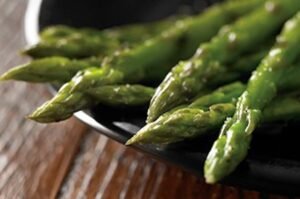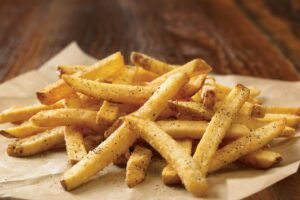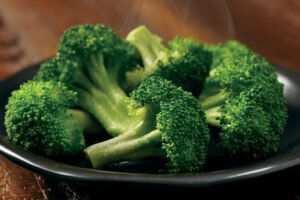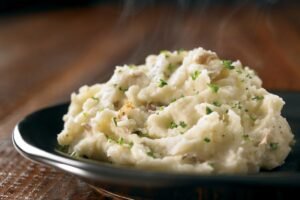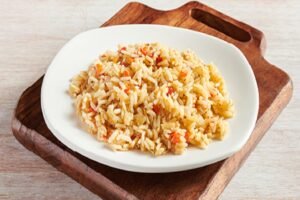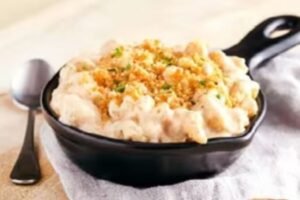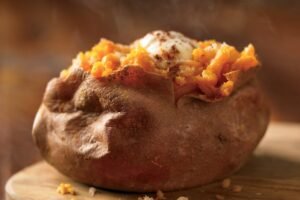At Outback, sides aren’t afterthoughts scraped onto plates to fill empty spaces. These freshly made accompaniments receive the same attention as the steaks they sit beside, transforming from supporting roles into co-stars that often steal the show. Each side undergoes specific preparation techniques that elevate simple ingredients into memorable components of the meal.
The side dish menu reflects Outback’s understanding that a great steak becomes extraordinary when paired with the right accompaniment. Whether it’s the signature loaded baked potato that weighs nearly a pound or the perfectly seasoned fresh vegetables, these sides complete the Outback experience.
Outback Steakhouse Side Dish Menu
The Loaded Baked Potato Mastery
The loaded baked potato at Outback isn’t just big – it’s engineered for maximum impact. Potato selection starts with Idaho russets weighing 12-14 ounces, checked for uniform shape and minimal eyes. Each potato gets scrubbed by hand, pierced 12 times with a fork for steam venting, then rubbed with oil and coarse salt.
Baking happens at 400°F for exactly 55 minutes directly on oven racks, not wrapped in foil which would steam rather than bake. The result creates crispy skin that contrasts with fluffy interior. After baking, potatoes rest in warming drawers at 165°F for maximum 2 hours – longer and they develop gummy texture.
The loading process follows specific layering. First, the potato gets cut lengthwise and crosswise, creating an X that opens when squeezed. Butter goes directly into the hot potato to melt, followed by sour cream that slightly melts from residual heat. Shredded cheese applies while potato remains hot enough to melt it, then bacon crumbles and green onions top everything.
Portion control matters – each loaded potato receives 2 tablespoons butter, 3 tablespoons sour cream, 1/4 cup cheese, 2 tablespoons bacon, and 1 tablespoon green onions. These measurements ensure consistency while controlling food cost.
Fresh-Cut Fries Excellence
Aussie Fries start their journey each morning when prep cooks transform 50-pound bags of potatoes into fresh-cut fries. The cutting happens using commercial french fry cutters that create 3/8-inch strips – thick enough to maintain potato flavor but thin enough for proper crisping.
After cutting, fries soak in cold water for minimum 30 minutes, removing excess starch that would cause sticking and uneven browning. The soaking water gets changed every 2 hours to prevent starch buildup that affects texture.
The double-frying method creates the perfect texture. First frying at 325°F for 3 minutes par-cooks the interior without browning. Fries then rest for at least 5 minutes before the second fry at 375°F for 2-3 minutes, creating golden-brown exterior while maintaining fluffy interior.
Seasoning happens immediately after the second frying while oil helps spices adhere. The signature blend includes salt, paprika, garlic powder, onion powder, and other proprietary spices applied from a shaker positioned exactly 10 inches above for even distribution.
Mashed Potato Perfection
Homestyle mashed potatoes use red-skinned potatoes for their waxy texture that holds up better than russets when mashed. The potatoes cook in salted water at a rolling boil for 18-20 minutes until fork-tender but not falling apart.
The mashing process requires specific technique. Potatoes drain completely – excess water creates gluey texture. Hot potatoes pass through a ricer rather than traditional mashing, preventing overworking that develops gummy consistency. Butter and cream get heated before adding, maintaining temperature while incorporating.
Fresh batches get made every 2 hours during service. Holding longer causes oxidation that grays the color and degradation of texture. The 2-hour rule wastes some product but ensures quality that instant or long-held mashed potatoes can’t match.
Garlic mashed potatoes follow similar process but incorporate roasted garlic purée. Whole garlic heads roast for 60 minutes at 350°F until completely soft and caramelized. The roasted cloves get squeezed out and puréed before folding into potatoes.
Vegetable Preparation Standards
Fresh vegetables arrive daily from regional suppliers, never frozen except for specific items like corn. Each vegetable type requires different preparation to optimize texture and flavor while maintaining nutritional value.
Asparagus only appears when spears measure 1/2 to 3/4 inch diameter – thinner overcooks quickly while thicker develops woody texture. Trimming removes exactly 1.5 inches from bottom, eliminating fibrous portions while maximizing yield. Grilling happens at high heat for 4-5 minutes, creating char marks while maintaining crisp interior.
Broccoli gets cut into uniform 2-inch florets ensuring even cooking. Steaming occurs in specialized equipment maintaining exactly 212°F for 3-4 minutes. This precise timing creates tender-crisp texture – a minute longer turns bright green to dull olive with mushy texture.
Mixed vegetables follow specific cooking order based on density. Carrots start first, requiring 5 minutes. Squash and zucchini add at 3 minutes. This staggered approach ensures everything finishes simultaneously with appropriate texture.
Mac & Cheese Craftsmanship
The five-cheese mac starts with a classic béchamel base – butter and flour roux cooked until blonde, eliminating raw flour taste. Whole milk gets added gradually, preventing lumps while creating smooth sauce. The cheese blend – sharp cheddar, mild cheddar, Monterey Jack, Parmesan, and Romano – melts in specific order based on melting points.
Cavatappi pasta gets chosen for its corkscrew shape that holds sauce better than traditional elbow macaroni. The pasta cooks to just under al dente since it continues cooking when mixed with hot cheese sauce and during the finishing bake.
The breadcrumb topping combines panko with melted butter and Parmesan, creating crispy contrast to creamy pasta. Final baking at 425°F for 8-10 minutes develops golden crust while heating throughout. Each order gets made individually in small cast iron skillets, ensuring proper crust-to-pasta ratio.
Rice Pilaf Precision
Rice pilaf preparation starts with toasting long-grain rice in butter until fragrant and lightly golden. This toasting develops nutty flavor while creating protective coating that prevents mushiness. Chicken stock, heated to boiling, gets added in precise 2:1 ratio to rice.
Cooking happens covered at exactly 180°F for 18 minutes – higher temperatures cause sticking while lower results in uneven cooking. After cooking, rice rests off heat for 5 minutes, allowing remaining moisture to distribute evenly.
Fresh herbs – parsley, thyme, and bay leaf – infuse during cooking then get removed before service. Butter gets folded in just before serving, creating richness without greasiness. The final product maintains individual grain integrity while delivering cohesive flavor.
Portion Control and Presentation
Each side dish follows specific portion guidelines ensuring consistency across locations. Loaded potatoes must weigh 12-14 ounces pre-cooking. Mashed potatoes portion at exactly 6 ounces using standardized scoops. Vegetables measure 4 ounces regardless of type.
Presentation standards dictate positioning on plates. Potatoes orient at 9 o’clock position, vegetables at 3 o’clock, allowing optimal spacing from protein. Heights matter too – mashed potatoes peak at 2 inches, creating visual appeal without overwhelming plates.
Garnishes remain minimal but purposeful. Mashed potatoes get single butter pat melting on top. Vegetables receive fresh herb sprinkle. These small touches signal freshness and attention to detail.
Customization Options
While not advertised, kitchens accommodate numerous side modifications. Plain baked potatoes for those avoiding dairy. Vegetables without butter for health-conscious diners. Extra crispy fries for texture lovers. These modifications require minimal effort but significantly impact satisfaction.
Substitutions between sides usually incur no charge when switching similar-priced items. Upgrading from regular to loaded potato costs the difference. This flexible pricing encourages customization without penalizing preferences.
Off-menu combinations exist for regulars who know to ask. Loaded mashed potatoes add bacon and cheese to regular mashed. Cheese fries top Aussie fries with the mac & cheese sauce. These secret preparations reward customer loyalty.
Seasonal Rotations
Seasonal vegetables rotate based on availability and quality. Summer brings corn on the cob, grilled with butter and lime. Fall features roasted root vegetables. Winter sees Brussels sprouts with bacon. Spring delivers fresh green beans.
These rotations follow growing seasons rather than arbitrary calendar dates. Florida locations might feature summer vegetables earlier than Minnesota. This regional flexibility ensures peak quality while maintaining variety.
Holiday periods introduce special sides. Thanksgiving week features cornbread stuffing and cranberry sauce. Christmas brings sweet potato casserole. These limited offerings create urgency and special occasion feel.
